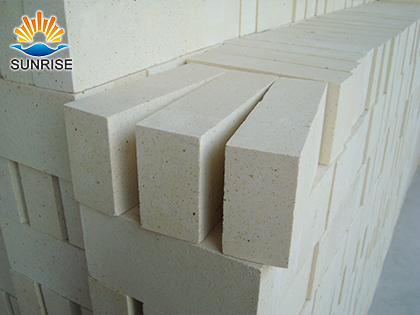Lightweight silica brick is also known as silicon heat insulation brick, refers to a heat-insulating silicon refractory product with a SiO2 content of more than 90% and a bulk density of less than 1.2g/cm3. Lightweight silica bricks generally use quartzite or silica as the main raw materials, and flammable substances such as coke, anthracite, carbonized rice husk. Light weight silica bricks are added to the ingredients, insulation silica bricks are produced by a gas foaming method and fired at a high temperature.
►Lightweight Silica Brick Features
1.Insulation silica firebrick have high refractoriness;
2.Insulation silica firebrick have gas corrosion resistance;
3.Insulation silica firebrick have high temperature resistance;
4.Insulation silica firebrick have good thermal insulation performance.
►Lightweight Silica Brick Advantage
Lightweight silica bricks with a porosity of about 50% have a lower thermal conductivity than lightweight clay bricks.
The weight deformation temperature of lightweight silica bricks reaches 1620℃ ~ 1640℃, while the lightweight clay bricks only have 1200 ~ 1300 ℃, the high temperature does not shrink, but expands at 1450℃ (about less than 0.2%), the volume is stable, and the clay shrinks lightly. Large, easy to make the furnace lining split.
Lightweight silica bricks can be used for a long time in furnaces operating at temperatures between 1550 and 1600℃, and can be used directly with the hot side of the furnace gas or on the roof of large spans.
The use of light weight silica brick in the heating lining can shorten the heating period and reduce the fuel consumption by 35% compared with the use of lightweight clay bricks. The use of lightweight silica bricks in the kiln top of the firing kiln (reverse kiln) can extend the life of the furnace roof.
1.Silica insulation bricks is mainly used in various parts of the kiln that require heat insulation or light weight reduction without direct contact with the melt, no corrosive gas, no temperature change. Used at high temperatures, Light silica fire bricks cannot be in contact with alkaline refractories. According to different materials, the maximum operating temperature is 1200~1550℃.
2.Light refractory bricks have large porosity and loose structure, and cannot be used for direct contact with molten slag and liquid metal.
3.The lightweight silica insulation bricks mechanical strength is low and cannot be used for load-bearing structures.
4.The lightweight silica insulation bricks wear resistance is very poor, lightweight silica brick is not suitable for contact with the charge, severe wear parts.
►Lightweight Silica Brick Application
1.Light silica fire bricks application in glass kiln roof, regenerator wall top;
2.Lightweight silica insulation bricks using in the insulation material for high temperature hot blast stove silicon brick lining for large blast furnace, thermal insulation layer for glass kiln silicon brick lining and thermal insulation for various industrial kiln, under high temperature conditions not in contact with slag For long-term use, the maximum use temperature of lightweight silica brick is between 1300-1550℃.
|
Item |
QG-0.8 |
QG-1.0 |
QG-1.1 |
QG-1.2 |
|
SiO2 % |
≥88 |
≥91 |
≥91 |
≥91 |
|
Bulk Density g/cm3 |
≤0.85 |
≤1.00 |
≤1.10 |
≤1.20 |
|
Cold Crushing Strength Mpa |
≥1.5 |
≥2.0 |
≥3.0 |
≥5.0 |
|
0.2Mpa Refractoriness Under Load T0.6 ℃ |
≥1400 |
≥1420 |
≥1460 |
≥1520 |
|
Permanent Linear Change On Reheating(%)1450℃X2h |
0~+0.5 |
0~+0.5 |
0~+0.5 |
0~+0.5 |
|
20-1000℃ Thermal Expansich10-6/℃ |
1.3 |
1.3 |
1.3 |
1.3 |
|
Thermal Conductivity (W/MK) 350℃ |
0.55 |
0.55 |
0.60 |
0.70 |

Factory strength »
























